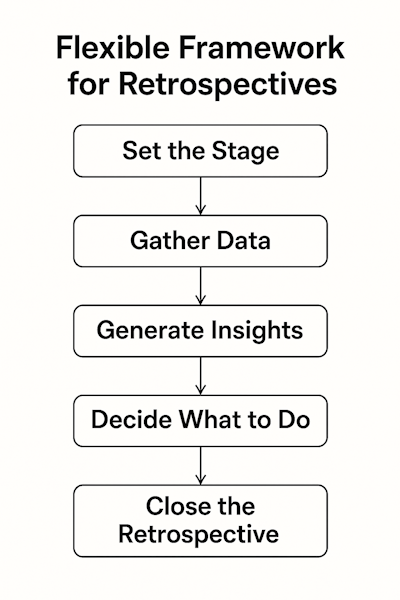Flexible Framework for Retrospectives
Outlines five elements for effective, adaptable Retrospectives.
"Retrospectives offer a safe haven for teams to learn and improve." 1

The Flexible Framework for Retrospectives is a structured yet adaptable model introduced by Esther Derby and Diana Larsen in their 2006 book Agile Retrospectives: Making Good Teams Great. Their five-stage approach - Set the Stage, Gather Data, Generate Insights, Decide What to Do, and Close the Retrospective - became the foundational rhythm for Agile team reflection. Designed to balance consistency with creativity, the framework provides enough structure to guide learning while allowing facilitators to vary activities based on the team's energy, maturity, or context. This combination of repeatable scaffolding and flexible content has made it a global standard for running effective Retrospectives that drive continuous improvement and team growth.
Impact
When Retrospectives follow the Flexible Framework, teams benefit from rhythm, variety, and increased depth of learning. Each component builds on the previous one to guide the team from reflection to experimentation.
- Improved Focus and Engagement:
- Each stage serves a clear purpose, preventing conversation drift.
- Variety keeps the format fresh and energizing.
- Greater Psychological Safety:
- Opening activities ease people into reflection and build trust.
- Facilitators can tune intensity depending on team state.
- Deeper Insight and Connection:
- Generative questions and visual tools support collective sensemaking.
- Shared themes emerge naturally across stages.
- Actionable Outcomes:
- Closing stages ensure follow-through, not just venting.
- Teams create experiments, not just to-do items.
The 5 Components of the Flexible Framework:
Each Retrospective should ideally include all five components, adapted to the team's context:
- Set the Stage:
- Purpose: Create psychological safety and set intent.
- Activities: Check-ins, icebreakers, or silent reflection
- Examples "One Word Check-In", "Weather Report", "ESVP"
- Gather Data:
- Purpose: Surface facts, events, or observations.
- Activities: Timeline creation, satisfaction histograms, graphs
- Examples "Mad/Sad/Glad", "Sprint Timeline", "Team Radar"
- Generate Insights:
- Purpose: Move from data to meaning and patterns.
- Activities: Root cause analysis, empathy mapping, cause-and-effect diagrams
- Examples "5 Whys", "Fishbone Diagram", "Circle of Influence"
- Decide What to Do:
- Purpose: Identify experiments or improvements.
- Activities: Prioritization, dot voting, impact/effort grids
- Examples "SMART Goals", "Lean Coffee", "Action Planning"
- Close the Retrospective:
- Purpose: Reflect on the session and reinforce team connection.
- Activities: Appreciation round, anonymous feedback, closing question
- Examples "One Word Wrap-Up", "Return on Time Invested (ROTI)"
These components create flow without over-controlling the experience, enabling facilitators to adjust depth and tone based on the team's current reality.
Scenario
A newly formed distributed team finds their Retrospectives unfocused and often rushed. The Scrum Master introduces the Flexible Framework and guides the team through its five stages in the next Retro:
- Starts with a "Team Mood Check" to build safety.
- Uses a virtual whiteboard to create a Sprint Timeline.
- Facilitates "5 Whys" on a persistent deployment failure.
- Teams dot-vote on experiments to improve CI/CD clarity.
- Closes with an appreciation round.
The result is a more grounded, energized team conversation that leads to meaningful experiments and a sense of shared ownership.
Ways to Mitigate Common Issues:
Teams often fall into patterns where Retrospectives become stale, one-dimensional, or skipped. Using the five components helps teams recover structure and reintroduce depth.
- Reinforce the Full Structure:
- Avoid skipping "Set the Stage" or "Close the Retrospective".
- Rotate activity styles to fit the emotional tone of the team.
- Support the Facilitator:
- Maintain a backlog of format ideas (e.g., use Retromat or Miro templates).
- Invite rotating facilitation or co-facilitation.
- Focus on Experimentation:
- Replace long action lists with one testable improvement.
- Use "Decide What to Do" to frame changes as experiments.
- Feedback Loop on the Retrospective:
- Use "ROTI" or a quick poll to inspect and adapt the Retro format.
- Incorporate meta-feedback into the next session design.
Conclusion:
The Flexible Framework for Retrospectives brings a deliberate, modular approach to Agile team reflection. By embracing all five components - Set the Stage, Gather Data, Generate Insights, Decide What to Do, and Close - the team not only strengthens their Retrospectives but also deepens their commitment to learning and improvement. This structure provides enough stability to guide powerful conversations while leaving room for creativity, experimentation, and emotional intelligence.
Key Takeaways
- The Flexible Framework consists of five core components that guide Retrospectives from check-in to closure.
- "Set the Stage" and "Close" are often neglected, but are vital for psychological safety and cohesion.
- Flexibility in activities within each component ensures freshness and depth.
- Consistent structure builds team confidence and enables deeper insight over time.
- Teams can co-create their Retrospective formats and rotate facilitation roles.
Summary
The Flexible Framework for Retrospectives is a practical, human-centered structure that enhances Agile team learning. With five adaptable stages, it encourages psychological safety, supports insight generation, and ensures each session ends with focused improvement. Rather than prescribing a single method, it offers a scaffold teams can build on, evolve with, and make their own.